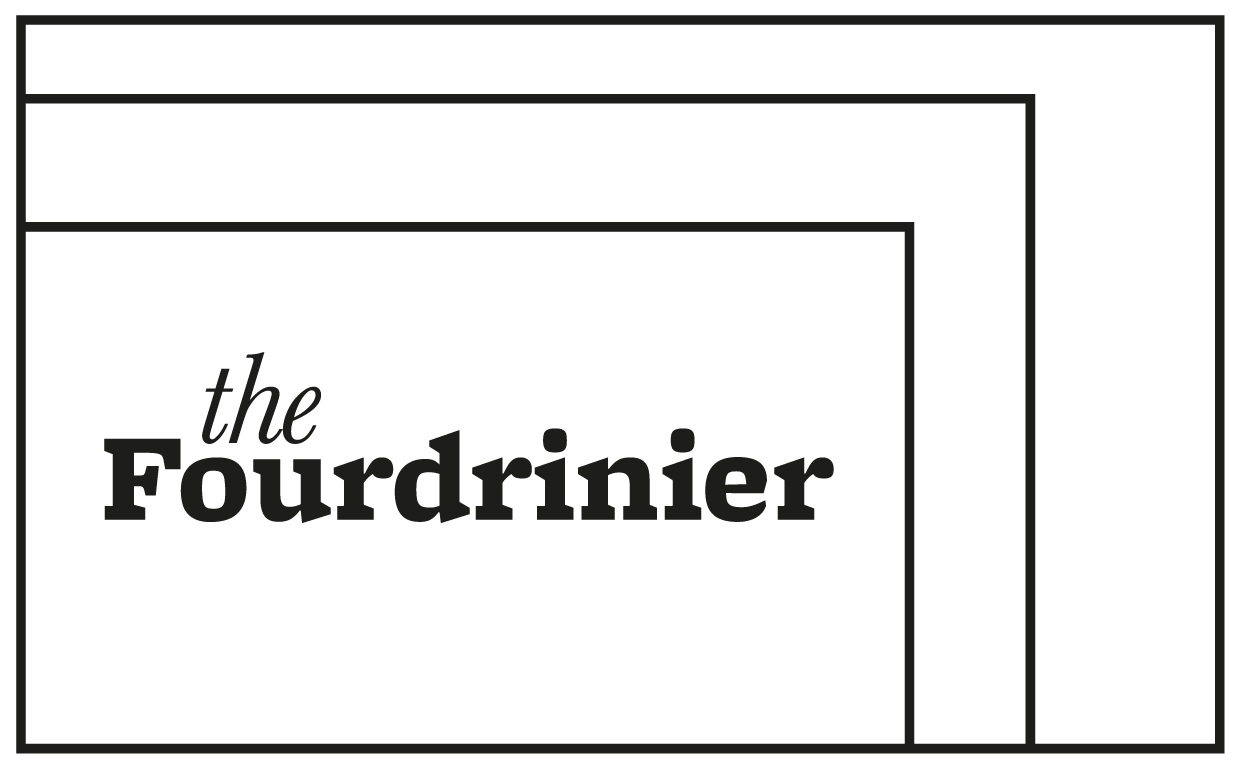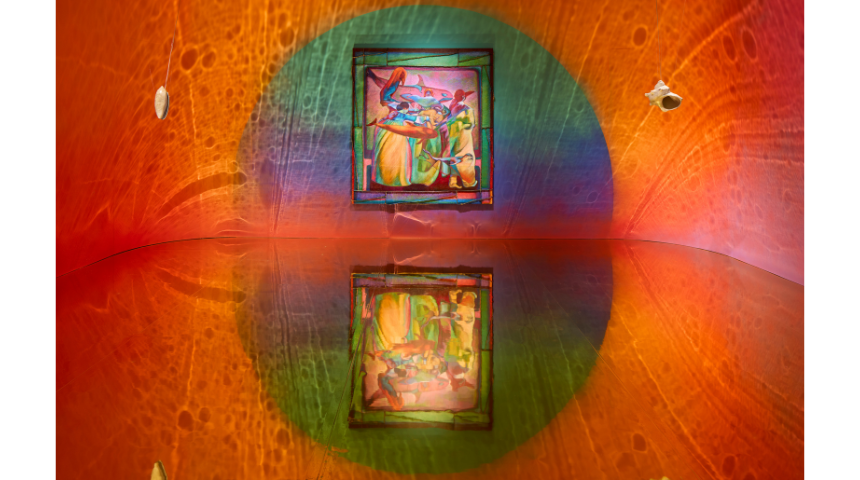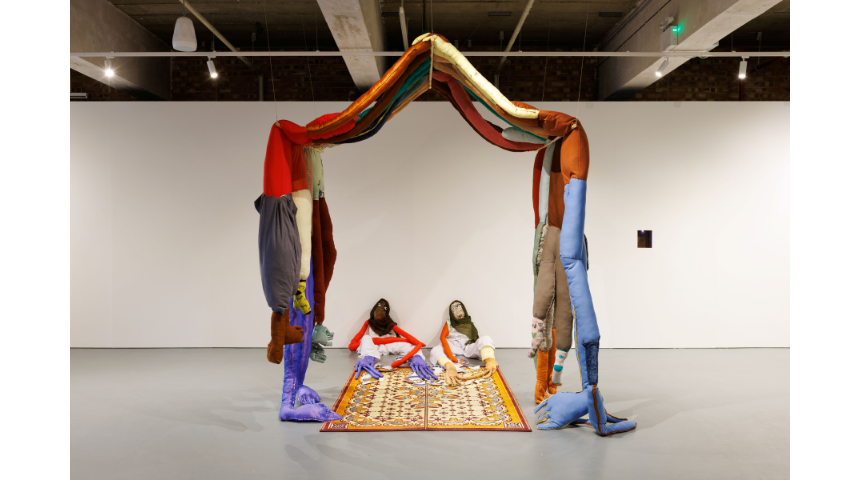FEATURE Nov 2025 Turner Prize & Practice Bradford
Charu Vallabhbhai
Installation view of Zadie Xa’s presentation at Turner Prize 2025, Cartwright Hall Art Gallery. Photo © David Levene
Writer and independent curator Charu Vallabhbhai takes in the wealth of visual art in Bradford, this year’s UK City of Culture, focusing on the four artists of the 2025 Turner Prize, and their four Practice Bradford counterparts, to present readers with a broad overview that opens onto a fascinating in depth exploration of their work. The Turner Prize is an annual award and its shortlist of four artists are shown in a group survey exhibition each year. Practice Bradford is an artist development programme providing funding, mentoring and opportunities, culminating in showing work in an exhibition.
The success of this year’s Turner Prize lies not only in its breath-taking presentation of four artists exhibitions, a convincing sample of the very best in the past twelve months contemporary art shows. It also triumphs in speaking to a breadth of audience through the relevance of its subjects and inherent issues, including race, identity, affinity with the natural world, neurodivergence and conflict. It’s the stuff that’s all around us and is distilled into our daily news and social media feeds. The Turner Prize comes to Bradford in accordance with Tate’s agreement with DCMS to take the annual exhibition to the place that is designated ‘City of Culture’. Turner Prize, under this arrangement, was previously shown in Derry, Hull and Coventry.
Historically presented since 1984 at the Tate Gallery on Millbank, now known as Tate Britain, it wasn’t until 2007 that Turner Prize was shown outside of London, at Tate Liverpool. The only other venues so far to show Turner Prize that are not Tate were Gateshead’s Baltic in 2011, Glasgow’s Tramway in 2015, Margate’s Turner Contemporary in 2019 and Towner Art Gallery, Eastbourne in 2023. The fact of Turner Prize being presented for only the eighth time in its 42 year history at a gallery this isn’t Tate is, in itself, something to be celebrated by audiences for contemporary art in Yorkshire.
Cartwright Hall is one of four buildings that comprise Bradford Museums and Galleries, each located in different parts of the district. Built on the former site of Manningham Hall, it is a purpose-built art gallery that opened in 1904 out of funds donated to the city by Samual Lister, a Victorian industrialist who became a multi-millionaire out of the production of woollen and worsted yarn and the manufacture of textiles. Together with his brother he was the owner of nearby Lister Mills. The park in which Cartwright Hall Art Gallery is situated takes his name, while the Art Gallery is named after Edmund Cartwright, in tribute to the eighteenth-century inventor of the power loom.
Cartwright Hall was designed in the Baroque style by the same architects as Glasgow’s Kelvingrove Art Gallery and Museum, Sir John W Simpson and E.J. Milner. The public park it stands in is arguably Bradford’s finest. Its water garden, inspired by parks in India, featured in Monty Don’s two-part BBC series about Paradise Gardens across South Asia. The adjacent Art Gallery is home to Bradford’s art collections, including a public collection of works by David Hockney with acquisitions that date back to before his Royal College of Art fame, making it an unrivalled public collection of his early work. Together with what is believed to be the largest the private collection of Hockneys at Salts Mill, a couple of miles north of Lister Park in Saltaire, Bradford is usually the destination to see the creative output its renowned twentieth century artist, though not through the duration of Turner Prize. Described as ‘one of the world’s best known prizes for visual art’, Turner Prize has taken over Cartwright Hall leaving collection displays to inhabit the open spaces that lead off the foyer and the landing. Bradford’s Kapoor, Shonibare and its Lowry’s, amongst a few other artworks and objects, have remained on display.
The four artists nominated for the Turner Prize are selected by a panel led by the Director of Tate Britain and each year a newly elected group of four judges will decide on the winner who will receive the Prize of £25,000 leaving the remaining three artists with an award of £10,000 each. It feels like the selection and judging panel are down-played in the exhibition with little, if any, information about them or the process leading to the decision on those four finalists. This is rather imbalanced, considering the influence the jury have and the impact that ‘winning’ could potentially make on the lives and careers Nnena Kalu, Rene Matić, Mohammed Sami and Zadie Xa.
Installation view of Mohammed Sami’s presentation at the Turner Prize 2025, Cartwright Hall Art Gallery. Photo © David Levene
Turner Prize chooses its four artists on the basis of solo exhibitions of their work not only in the UK but internationally with Rene Matić selected for their exhibition ‘As Opposed to the Truth’ at Center for Contemporary Arts Berlin, Sami for ‘After the Storm’ at Blenheim Palace, Oxfordshire and Kalu for her works ‘Hanging Sculpture’ at Manifesta 15 in Barcelona as well as the inclusion of ‘Drawing 21’ in the group show ‘Conversations’ at Walker Art Gallery in Liverpool. Curiously, Zadie Xa has been nominated for her collaboration with fellow artist and partner Benito Mayor Vallejo at Sharjah Biennial 16 together with whom she has worked for the past nine years. So, for what reason was Xa selected and not Mayor Vallejo? Two of the artists are commercially represented by Arcadia Missa Gallery in central London. Matić is also with Chapter New York. Sami is represented by Patrick Heide Contemporary Art in London and Luhring Augustine in New York while Zadie Xa’s gallery Thaddaeus Ropac has presence in Paris, London, Salzburg, Milan and Seoul.
Many artists will never achieve this level of commercial success, instead having a job that supports their creative practice which ultimately means they have less hours in a week to devote to work they feel passionate about making. Commercial galleries, of course, invest in their artists because they will reap financial return at the point of sale. They also make it their business to place their artists under the noses of public collections and galleries, reinforcing their worth in a circular manner. While publishers and record labels promote writers and musicians, also for financial gain, the figures differ, as books and records are sold at an affordable unit price, accessible to a broader consumer base and therefore rely on audiences for books and music in order to reap commercial success through multiple sales. While the relationship between public and private sector galleries remains ever so slightly murky, the fact is that this year’s Turner Prize does bring together four exhibitions of incredibly beautiful, relevant and bold work that make Cartwright Hall’s galleries look like they have never appeared before.
The architectural layout of Cartwright Hall’s exhibition spaces, with two large rooms on the ground floor and two above, lend perfectly to the Turner Prize and it therefore gives the impression of having been devised entirely for these very galleries. The Hockney Gallery, usually crammed full, has been emptied and replaced by seven paintings by Iraqi artist Mohammed Sami. While some critics have questioned the timidity of a painter being nominated for Turner Prize, Sami executes these works on linen with the accomplishment of painters such as Peter Doig, offering a post-modernist freshness to this centuries old art of rendering images, from life or memory, in paint. The subject of Sami’s works also traces back to the beginnings of humanity: the devastation of war, dictatorship and destruction but with 21st century weapons that include lasers, reminiscent of scenes from Mike Trim’s cover artwork for the album adaption of ‘The War of the Worlds’ (1898) by H G Wells. Sami, born in Baghdad in 1984, is an artist with lived experience of contemporary conflict. In this series of paintings though, there is an absence of people with only traces of their being. Clothes discarded by a couple, bobbing under water like jelly fish. Crockery smashed in a tangle of flying matter and a damaged portrait of a military hero. Rather than depicting a narrative the scenes are more snapshots, moments and fragments that could be the basis of a story that claims to be fact but indicate that truths are often only told from a single perspective.
In the opposite gallery, which is wood-panelled, Nnena Kalu’s brightly coloured drawings on paper and three-dimensional forms are installed. Their impact is striking: they embody the language of an autistic and learning disabled artist with limited verbal communication. They demand that the audience perceives and interprets in a way that relies on sensory response to the forms and drawings made through repeated swirling movement, turning, wrapping and winding. The objects in this exhibition are made from discarded materials such as fabric scraps, plastic piping and VHS tape. They are suspended within the room and gently sway as the air circulates around the gallery, giving away their lightness which is not comparable to their volume and visual dynamism.
In the gallery immediately beneath Kalu’s is a recreation of Xa’s immersive installation for Sharjah Biennial. Elements within the space are acknowledged as a collaboration with Mayor Vallejo with the paintings themselves solely credited to Xa. Here, at Cartwright Hall, the addition of a brass-coloured, mirror polished floor accentuates the sense of entering a realm underwater where myths unfold, by casting ripples onto the walls and ceiling. The title of the room ‘Moonlit Confessions Across Deep Sea Echoes: Your Ancestors and Whales and Earth Remember Everything’ alludes to a primordial emergence of life forms from the oceans and an evolutionary lineage that is stored, like fossils, as memory within the composition of our planet. Folklore is captured on the wall mounted paintings like hieroglyphs in a tomb or cave paintings depicting stories of women, sea-creatures and skeletons that are to be handed down. Science and myth-making collide in this other-worldly, dream-like place. The linen supports are machine stitched by Xa with patchwork edges that are reminiscent of the stained glass windows of the Catholic churches she recalls visiting as a child.
Saba Siddiqui A Well Deserved Cuppa (2025) OUR TURN Practice Bradford, Yorkshire Contemporary, Photo Jules Lister
Across the foyer Rene Matić’s space offers a sober reminder of the place we have come to, here and now in the 21st century. Whose vision is this fractured reality in which the lessons of the civil rights movement and anti-apartheid struggles have taught too many nothing at all? Dangerous far-right politics divide nations and communities, appealing to those whose anger is channelled to aim in the wrong direction, mis-firing. This is the result of being too easily misled and emphasises how simple it is to mislead. In Matić’s photographs of contemporary life flags, banners and wreaths are reclaimed while exclaiming one’s identity and protesting against those who dare to ‘other’ those they chose to marginalise.
Down the road in Bradford’s city centre, another exhibition was held for a month from 18 October, in which four emerging artists with a connection to Bradford had been selected, through open call, to participate in a scheme that provides funding and mentorship. The ‘Practice Bradford’ programme culminated in a group exhibition at a new a cultural venue, Loading Bay, in the heart of the city. The name doesn’t give away its offer to theatre and gallery-goers but refers to its former use as the inner-city storage facility for Marks and Spencer, which once occupied a building on the parallel main shopping street, harking back to the days before out-of-town warehousing facilities and retail parks.
Each of the artists in ‘Practice Bradford’ have actively chosen to participate in the programme which differs from the process of being nominated for Turner Prize. This raises the question of whether any artists have ever actively rejected a Turner Prize nomination. For a group exhibition that wasn’t intended to reflect a common theme, what ties these works together is their reference to Bradford, the place that each artist has a relationship with. Atiyya Mirza and Liv Preston both grew up in the district, Joanna Byrne currently lives in Bradford and both she and Saba Siddiqui make their work there.
Mirza has created an installation of textiles and found materials to make ‘Our Ghar’. Fusing together the two languages she speaks, English and Urdu, Mirza reflects on the idea of home (ghar) being more than the fabric of a building but also the community, the family and the traditions that have nurtured her. Rather than a permanent and solid structure, Mirza expresses home as a place that evolves as generations respond and adapt to current times, challenging patriarchal beliefs and expectations. Like Siddiqui, Mirza graduated in Art and Design studies that gave both artists the freedom to experiment in different materials and, in each case, develop a love of textiles and the possibilities of working in the tactile material of cloth. Their installations encourage active interaction, inviting the visitor to enter the spaces each of the artists have created.
Atiyya Mirza Our Ghar (2025) OUR TURN Practice Bradford, Yorkshire Contemporary, Photo Jules Lister
Siddiqui spent part of her childhood and school years in Sheffield with fond memories of visiting Bradford’s fabric stores and south Asian restaurants with her parents. Her installation, ‘A Well Deserved Cuppa’ is multi-sensory, engaging the audience through sight, touch, smell and sound with the histories of labour and activism in the city’s textiles industry and of colonial impact on the migration routes that Bradford has been shaped by. Incorporating archival audio recordings, Siddiqui’s installation is a feast in the form of a tea-break comprised of sumptuous fabric, voices and smells. Seductively enticing the visitor to the table, Siddiqui subversively questions authority and rule, exposing historical neglect towards workers and their rights which lead to fracture in industrial relations.
While Liv Preston now lives in London, her fascination with Bradford’s subcultures and its subterranean geographical characteristics continues to inform the work she makes. Formation of the natural environment and how it once served its population through mining, or hobbyists seeking access to the ancient underworld of caverns, feed into the work Preston has created. All five works presented by Preston have been acquired, made by another’s hand or fabricated for mass production. A porcelain basin and miniature scaled down motor-cycle (a pit-bike) are covered in lead, a toxic heavy metal that was extracted locally. Utilised in roofing, window leading and plumbing it was once the material that formed the pipework carrying drinking water to our homes and required skilled tradespeople trained to manipulate and apply it. In learning the safe handling and application of lead, here layered over the found objects, Preston carries forward the expertise of professions that are now scarce. Embedded into the gallery walls are small glass negative and copper plates that Preston has lit up to reveal scenes from past adventures of Bradford Pothole Club, celebrating the interests of small groups and societies.
In the body of work that makes up ‘Past Lives’ Joanna Byrne, Like Preston, explores topography and history. She makes a specific place that once was the location of a pub and cinema her subject. Using still and moving images Byrne poetically captures this now unused former destination for the locals in the Shipley area of Bradford. It is the urban space that silently witnesses a high volume of heavy goods vehicles that pass daily along a major arterial route in a residential district. It is a non-place, shown by Byrne through the lens of magical realism and imagined as an enchanting, rewilded beauty-spot that has been reclaimed by nature in the absence of human value. In researching photographic practices that promote ecologically safe methods, Byrne has discovered that the very plants growing on the site that she makes her subject could be used to hand-develop her photographic film in the place of harmful dark-room chemicals. Byrne demonstrates how nature gives back abundantly in the quiet backdrop to the hum-drum of our existence.
Joanna Byrne Past Lives (2025) OUR TURN Practice Bradford, Yorkshire Contemporary, Photo Jules Lister
‘Practice Bradford’ was the exhibition that launched the ‘Our Turn’ festival. It is a programme that has been designed and led by the Bradford’s artists and organised by South Square Centre in collaboration with Bradford Producing Hub, Yorkshire Contemporary and Bradford 2025. Devised to coincide with the Turner Prize, ‘Our Turn’ platforms the visual artists who are dedicated to the district’s vibrant arts scene. ‘Our Turn’ continues with the ‘Bradford Art Show’ at Loading Bay from 6-21 December and ‘Artist’s Showcase’ in which 14 local artists have been commissioned to make and present new work at variety of venues and locations across the district. The winner of this year’s Turner Prize will be announced on 9 December. The exhibition continues to 22 February 2026





